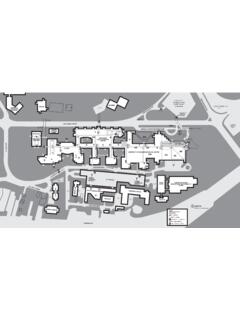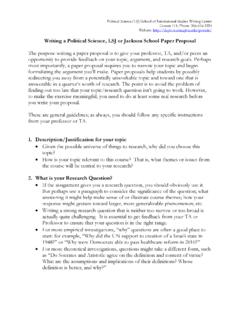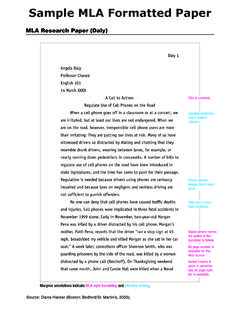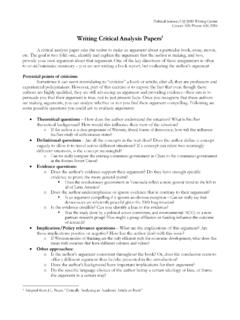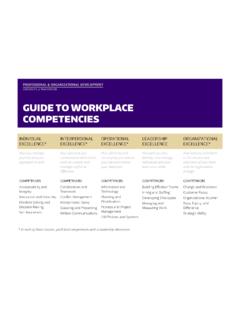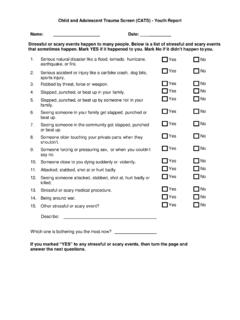Transcription of Social Connectedness, Dysfunctional Interpersonal ...
1 Journal of Counseling Psychology2001, Vol. 48, No. 3, 310-318 Copyright 2001 by the American Psychological Association, DOI: Connectedness, Dysfunctional Interpersonal Behaviors, andPsychological Distress: Testing a Mediator ModelRichard M. LeeUniversity of Minnesota, Twin Cities CampusMatthew Draper and Sujin LeeUniversity of Texas at AustinThe study examined the relationship among Social connectedness, Dysfunctional Interpersonal behaviors,and psychological distress. The authors specifically hypothesized that the direct negative effect of socialconnectedness on psychological distress would be mediated by Dysfunctional Interpersonal to testing the hypothesis, the authors revised the original Social Connectedness Scale (SCS; R.)
2 & S. B. Robbins, 1995). Studies 1 and 2 describe the revision and validation of the SCS on separatesamples of college students. In Study 3, the authors surveyed 184 college students and found support forthe mediation hypothesis on general psychological distress. The importance of assessing Social connect-edness and tailoring counseling interventions for people with low connectedness and dysfunctionalinterpersonal behaviors is most people, a lack of belongingness in life is a temporary,unpleasant experience that is overcome by reappraising relation-ships, mending friendships, seeking new Social bonds, and partic-ipating in Social activities. These people never feel fully discon-nected from society as a whole and are able to make appropriateinterpersonal changes in their lives to reestablish a sense of be-longing.
3 For a smaller segment of the population, a lack of be-longingness is a persistent and pervasive experience that is psy-chologically distressing and potentially debilitating. Theseindividuals have some friendships but nevertheless tend to feel likeloners or outsiders. They have difficulty maintaining relationships,avoid Social activities because of fear of rejection or exclusion, andtend to be interpersonally ill-equipped to overcome their circum-stances (Rook, 1984).Lee and Robbins (1995), drawing on psychoanalytic self-psychology theory (Kohut, 1984), have characterized this type ofbelongingness (or the lack thereof) as more precisely a sense ofsocial connectedness.
4 Social connectedness is considered an at-tribute of the self that reflects cognitions of enduring interpersonalcloseness with the Social world in toto. Lee and Robbins (1998)later characterized Social connectedness as a type of relationalschema or a "cognitive structure representing regularities in pat-terns of Interpersonal relatedness" (Baldwin, 1992, p. 461). Theemphasis on Social connectedness is on the independent self inrelation to others. Social connectedness, in this sense, is differentthan belongingness as defined by group membership or peer affil-iation (Baumeister & Leary, 1995) and loneliness as defined byemotional feelings regarding the loss of specific relationshipsRichard M.
5 Lee, Department of Psychology, University of Minnesota,Twin Cities Campus; Matthew Draper and Sujin Lee, Department ofEducational Psychology, University of Texas at concerning this article should be addressed to RichardM. Lee, Department of Psychology, Elliott Hall N218,75 East River Road,University of Minnesota, Minneapolis, Minnesota 55455. Electronic mailmay be sent to & Ickes, 1989). The emphasis on the independent selfalso differs from that of other theorists ( , Chodorow, 1978)who define connectedness as an expression of the interdependentself in which the self and other are interconnected and mutuallydependent on each to self-psychology theory (Baker & Baker, 1987;Detrick, 1985; Kohut, 1984; Lee & Robbins, 1995), a sense ofsocial connectedness develops early in life and extends throughoutthe life span.
6 In childhood, for example, parent-child attachmentsprovide an initial sense of security and likeness with others. Inadolescence, peer affiliations and group memberships allow indi-viduals to identify with others who share similarities in appear-ance, interests, and talents. By adulthood, the aggregate of thesepast and present relationship experiences are gradually incorpo-rated into one's overall sense of self, providing a relatively stablepsychological sense of connectedness that is not susceptible tovacillations in relationships, such as the loss of a friend or socialexclusion from a group (Lee & Robbins, 1998). People with highconnectedness tend to feel very close with other people, easilyidentify with others, perceive others as friendly and approachable,and participate in Social groups and activities.
7 As Baker and Baker(1987) noted, these adults have a greater tolerance and respect forinterpersonal differences and temporary lapses in belonging be-cause an underlying sense of connectedness girds people who experience acute or repeated Interpersonal failuresin life ( , abandonment, peer rejection, isolation, criticism)experience narcissistic wounds to the self and are more likely tomanifest low connectedness in adulthood (Lee & Robbins, 1995).That is, they have incorporated more negative relationship expe-riences into their sense of self. People with low connectedness tendto feel interpersonally distant from other people and from theworld at large. They often see themselves as outsiders, feel mis-understood by others, have difficulty relating with the socialworld, and are uncomfortable in Social situations.
8 They are able todevelop some relationships with people and groups, but theynevertheless feel a lack of connectedness deep within themselves310 Social CONNECTEDNESS311that subsequently affects their ability to interact with the largersocial (1984) speculated that people with low connectednessfail to develop appropriate Interpersonal behaviors necessary tomaintain relationships later in life or conversely they developdysfunctional Interpersonal behaviors. For example, children oftenimitate the behavior of their parents and siblings to feel close tothem. Adolescents and adults in the same way identify sharedinterests and talents ( , reading, sports) as well as developappropriate Interpersonal skills ( , sociability, intimacy, asser-tiveness) to attract and maintain relationships.
9 These various in-terpersonal behaviors draw people closer together and subse-quently validate a sense of connectedness. However, people withlow connectedness do not possess or exhibit these appropriateinterpersonal behaviors; they instead rely on more dysfunctionalinterpersonal behaviors characteristic of people with insecure at-tachment styles ( , avoidant and hard to be sociable, intimate,assertive; Hazen & Shaver, 1987; Rook, 1984). These dysfunc-tional Interpersonal behaviors are adopted in an effort to avoidfurther criticism or rejection but ultimately lead to greater psycho-logical distress (Lee & Robbins, 1995).Empirical support for the relationship between Social connect-edness and psychological adjustment is relatively well-documented across subdisciplines of psychology (McWhirter,1990; Rook, 1984).
10 People with low connectedness often experi-ence loneliness, anxiety, jealousy, anger, depression, low self-esteem, and a host of other negative emotions (Baumeister &Leary, 1995). It should be noted, however, that the majority of thisresearch has been conducted on other psychological constructs,such as attachment styles, loneliness, perceived Social support, andcollective self-esteem, which only tap into aspects of connected-ness (or the lack thereof) but not the full construct. To address thismeasurement gap in psychological research, Lee and Robbins(1995) developed the Social Connectedness Scale (SCS) to mea-sure Social connectedness as described by Kohut (1984).



